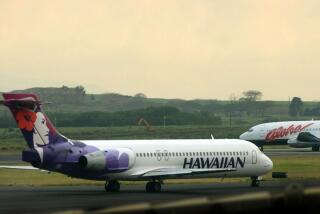American, US Airways approve merger
- Share via
A long-anticipated merger of American Airlines and US Airways is expected to be announced Thursday after weeks of closed-door negotiations, according to people briefed on the deal. The transaction would create the nation’s largest carrier and cap an era of consolidation in a troubled industry.
The marriage of American, based in Fort Worth, and its smaller competitor based in Tempe, Ariz., would form an airline valued at $11 billion. The union would be the latest in a string of mergers and acquisitions in an industry struggling to stay airborne amid fluctuating fuel costs, labor strife and economic turbulence.
The new airline would retain the name American, have its headquarters in Fort Worth and be the biggest carrier in eight of the nation’s largest airports including Los Angeles, according to the sources, who were not authorized to speak publicly. The airline is expected to surpass its competitors in revenue, passengers served and fleet size. In the first few years, the merger could generate savings and increased revenue of up to $1.2 billion, according to Robert Herbst, an industry consultant.
Quiz: Test your knowledge about airport security
But critics say another airline merger would only hurt passengers.
With newly merged airlines eliminating overlapping service, fares are certain to rise and carriers will probably stop serving less-profitable markets, some critics argue. Since 2007, the average domestic airfare has increased 15%, according to federal statistics.
“You don’t have to be an economics professor to understand that less competition in the market is going to result in consumers paying more, and airfares are certainly not immune from this simple fact,” said Brandon M. Macsata, executive director of the Assn. for Airline Passenger Rights advocacy group.
But industry experts predict the merger of American and US Airways won’t lead to significant fare increases because the two airlines rarely compete head to head, and because there are enough other airline competitors in the market.
“Out of all of the major airline mergers we’ve had in the last decade, this merger has the least amount of overlapping of flights and routes,” Herbst said.
In fact, the airlines seem to complement each other in several ways.
US Airways now has a large presence in mid-size markets such as Charlotte, N.C., Philadelphia and Phoenix, while American Airlines dominates in some of the nation’s largest airports, with more international destinations.
“American likes to be a presence in big markets, and US Airways likes to be No. 1 in small markets,” said Seth Kaplan, a managing partner at Airline Weekly, a trade magazine.
The merger must still be approved by federal regulators, but industry experts don’t expect opposition.
The deal would mark the latest in a series of mergers and acquisitions that has narrowed the industry to a handful of mega-airlines and several smaller, regional carriers.
In the last five years, Delta has merged with Northwest Airlines, United has merged with Continental and Southwest has acquired AirTran — resulting in a 10% drop in passenger capacity, according to a study by the International Air Transport Assn., an industry trade group.
The odds of a merger increased when American’s parent company, AMR, filed for bankruptcy in November 2011. Many analysts and AMR creditors argued that American could compete against other big airlines only by joining forces with another carrier to reduce costs and expand its service area.
For months, US Airways pushed for the merger, with American’s top executive initially resisting until it became clear that the carrier’s unions and many of its creditors supported a deal.
Another thorny issue that may have delayed a merger announcement was deciding who would run the new company. Board members for the two airlines have reportedly agreed to name US Airways Chief Executive Doug Parker as CEO of the merged airline. AMR’s chief executive, Thomas Horton, will be non-executive board chairman.
The ownership of the new airline will be split 72% for AMR creditors and 28% for US Airways shareholders.
One of the toughest parts about pushing through a merger — the integration of unions and their often conflicting contracts — has been already largely ironed out. The merger must still be approved by the Bankruptcy Court.
More to Read
Sign up for Essential California
The most important California stories and recommendations in your inbox every morning.
You may occasionally receive promotional content from the Los Angeles Times.










